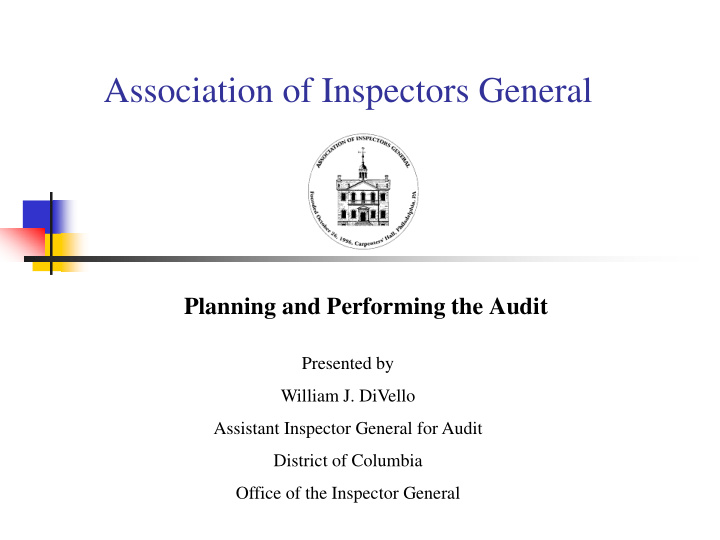



Association of Inspectors General Planning and Performing the Audit Presented by William J. DiVello Assistant Inspector General for Audit District of Columbia Office of the Inspector General
Objectives This course will provide an overall strategy/approach on how the senior auditor will conduct audits from the time of assignment to completion of the fieldwork and issuance of the final report. (Emphasis – Audit Survey) 2
Factors to Consider in Planning the Audit Auditors must adequately plan and document the planning of work The plan needs to address audit risk Identify relevant criteria Assign qualified staff Prepare written audit plan 3
Basic Theme Good Audit Survey = Quality Audit 4
Agenda The audit survey – what is it Typical survey approach Survey information needs Ways to obtain survey information Summarizing survey results Test 5
The Audit Survey – What is it? The first step in an audit An educational process Risk assessment of the audited entity 6
Main Purposes Identifying problem areas warranting additional review Obtaining information for use in planning and performing the detailed review work to follow 7
Focus Of Survey Economy and efficiency Program results 8
Audit Survey Factors Technical Needs Background Previous Audits Management Input Management Reviews Audit Internal controls Survey Automated Debrief Legal Implications Systems/Databases Available Audit Guide Program Resources 9
Risk Assessment Factors Mission Asset Values Funding Procurement Prior Audits Vulnerability/Internal Controls 10
Typical Survey Approach Broad Appraisal Narrow Narrow Scope 11
Practical Information How the operations are actually carried out How necessary or useful the various work steps are The process used to monitor results, and Whether the work satisfies legal requirements, established goals, and common sense practices. 12
Survey Information Needs General Background information on the agency and the programs and activities it administers; Extent and nature of the agency’s authority and responsibility; Goals and objectives established by legislation and by the agency; and Preliminary observations on the extent desired goals are being achieved, 13
Background Information Organization Financing Operating methods 14
Authority Laws Legislative history Judicial decisions 15
Goals and Objectives Economy and efficiency audits Program results 16
Ways To Obtain Survey Information Discussions with agency officials Interviews with others Physical inspection Reviews of management’s reports Test transactions Flow charts 17
Summarizing Survey Results The problems and rationale for pursuing them in more depth Pertinent information developed during the survey phase, Suggested work steps and the reasons for them, Preliminary estimates of time and resource requirements – particularly for personnel Target date for completing the review and reporting phases 18
Reporting Survey Results Background information about the program, system, activity, criteria, or function(s) to be reviewed. Management comments, suggestions, and other pertinent results of the entrance conference. A statement concerning coordination with other Government auditors, investigators, and inspectors, when applicable. 19
Reporting Survey Results A statement on whether prompt and appropriate corrective actions have been taken by officials of the reviewed organization(s)/program(s) on the recommendations in the most recent IG and Government Accountability Office reviews (pertaining to the areas under audit). Identification of automated systems/databases from which data should be extracted to perform the audit. Staff will use professional judgment in determining whether the information is sufficiently reliable and valid. Audit objectives and scope and, if appropriate, justification for proposed changes in objectives. A firm recommendation to either (1) proceed into the verification phase or (2) curtail audit work. 20
Audit Verification Detailed testing Progress and Accomplishments Finding Development 21
Audit Control Mechanisms In-Process Reviews Index of Findings Finding Outline Draft Finding 22
12 Step Approach to Performing a Quality Audit Maintain neat, organized working paper files 1. Prepare audit Guide program (AGP) 2. Reference AGP to workpapers 3. Make sure to explain purpose, source, scope, and 4. methodology Initial workpapers 5. Reference summary worpapers to supporting 6. workpapers 23
12 Step Approach to Performing a Quality Audit (con’t) Document supervision 7. Ensure that preparer and reviewer are never the same 8. Have an independent referencing review conducted 9. over the work Document necessary corrections based on IRR 10. Maintain a cross-index of draft and final reports 11. Ensure compliance with GAGAS 12. 24
Summary Emphasis – Audit Survey Verification 25
Recommend
More recommend